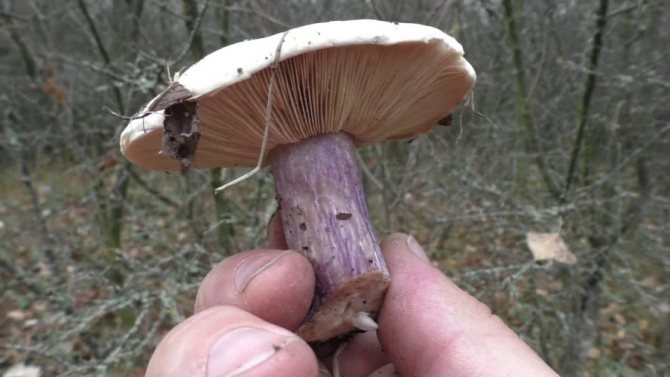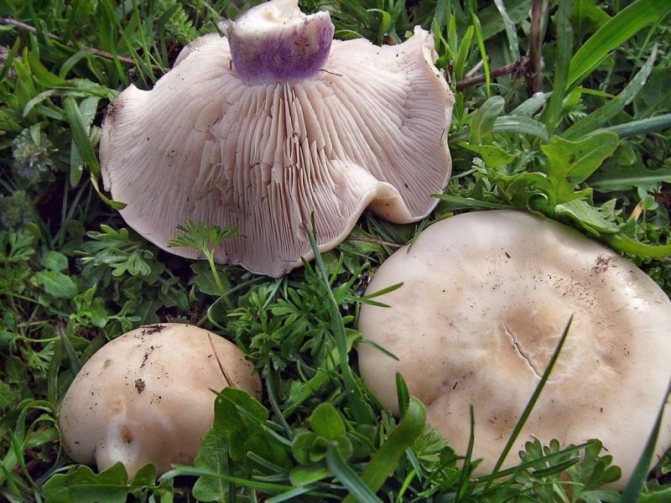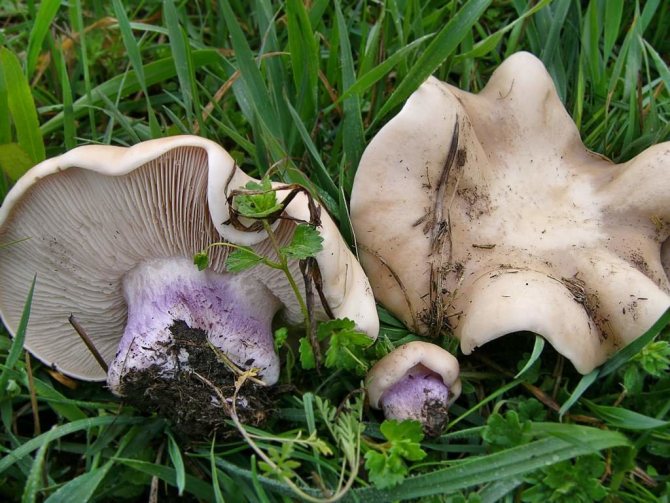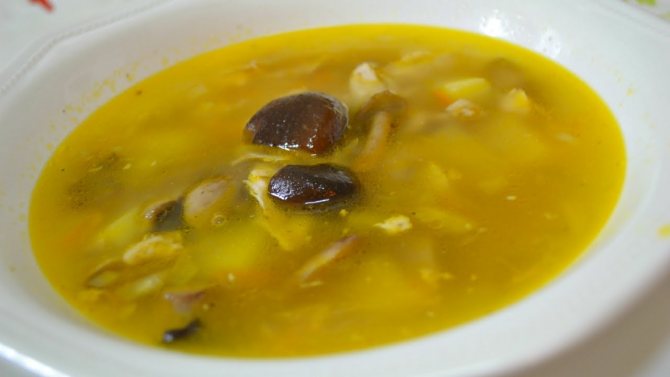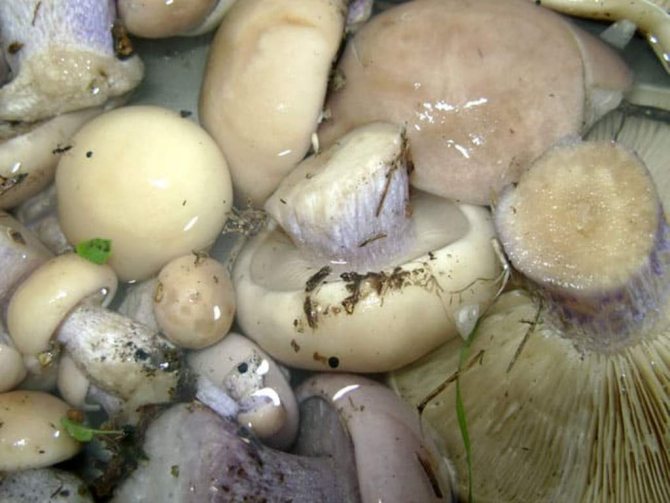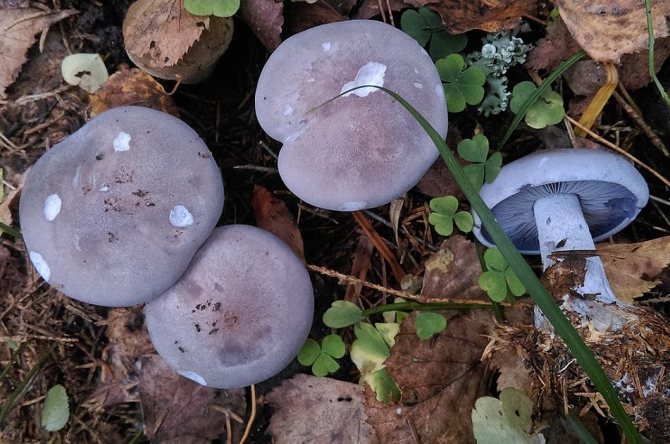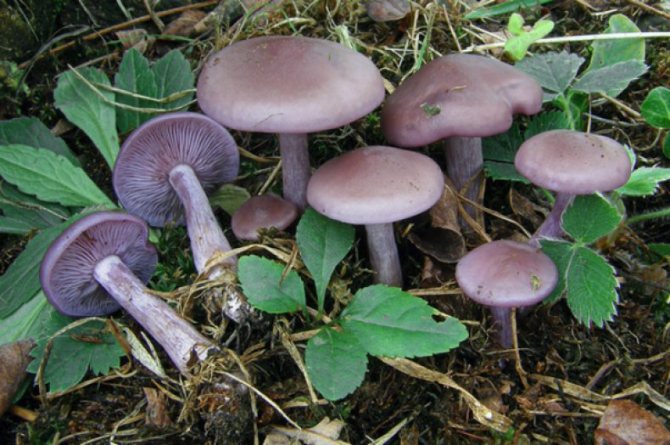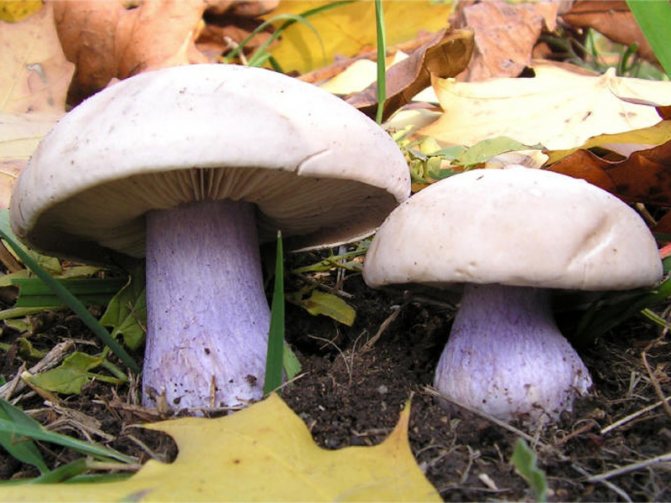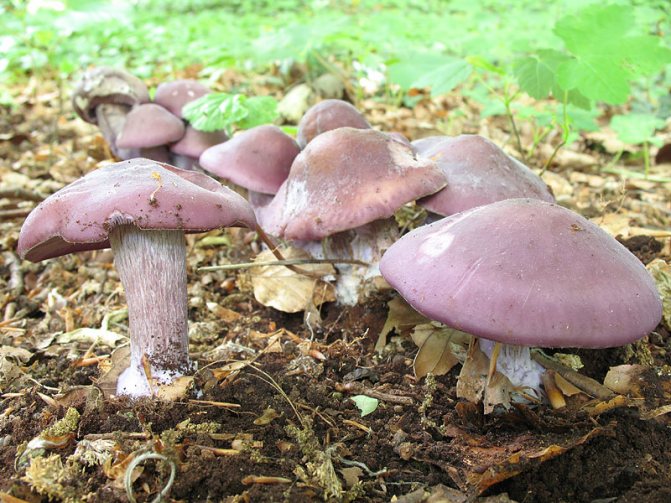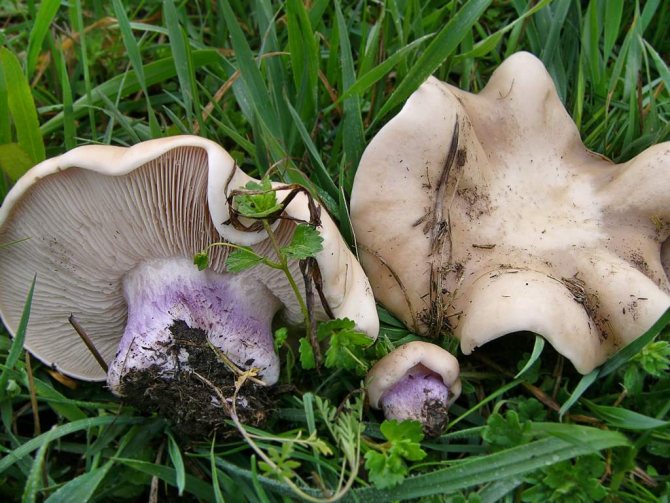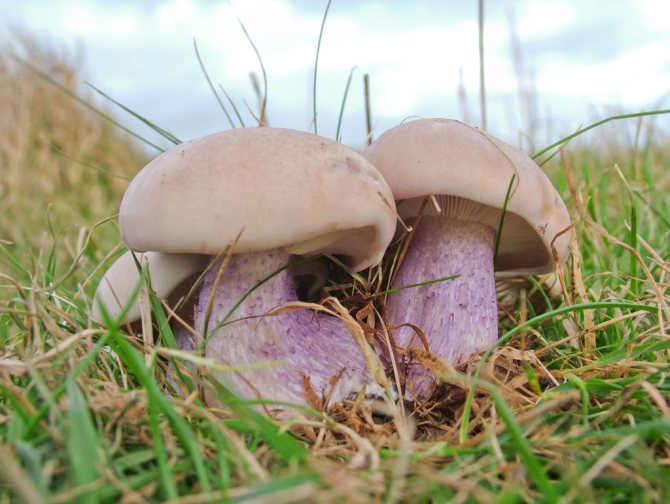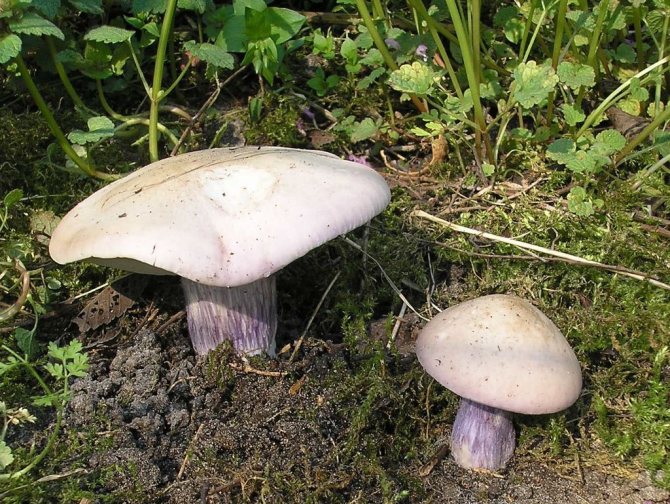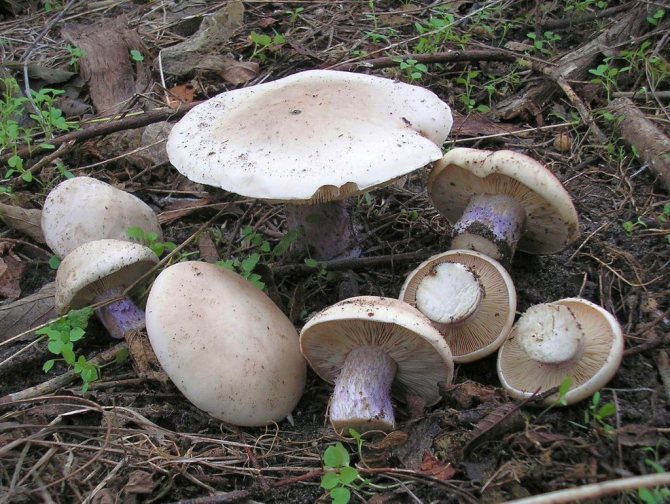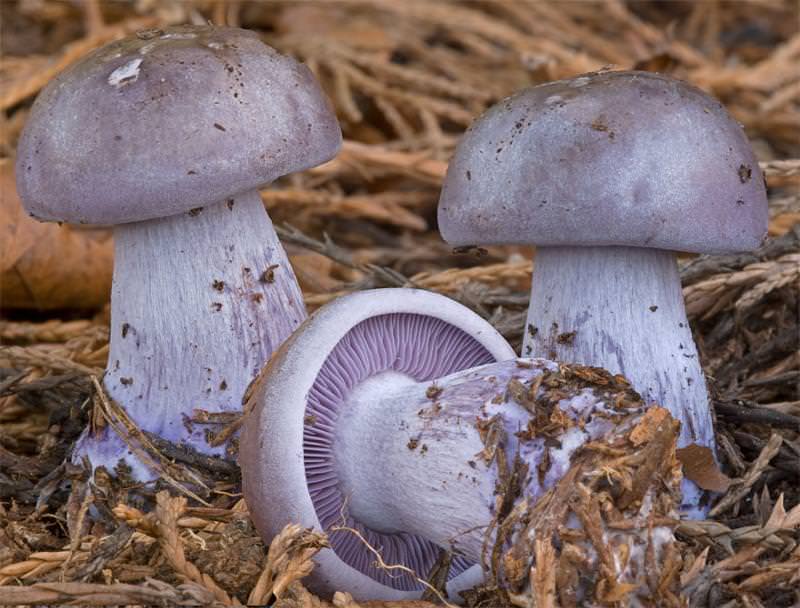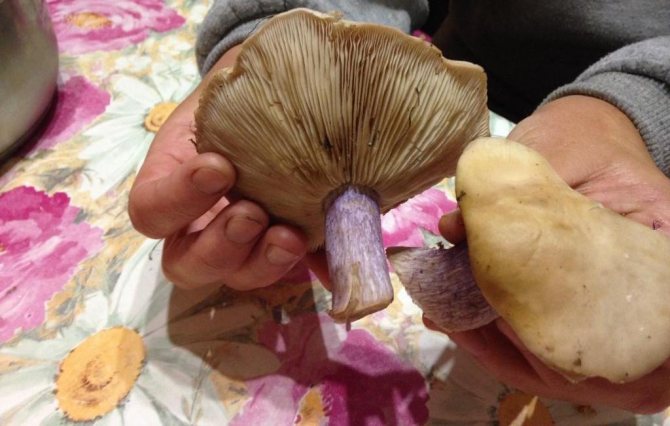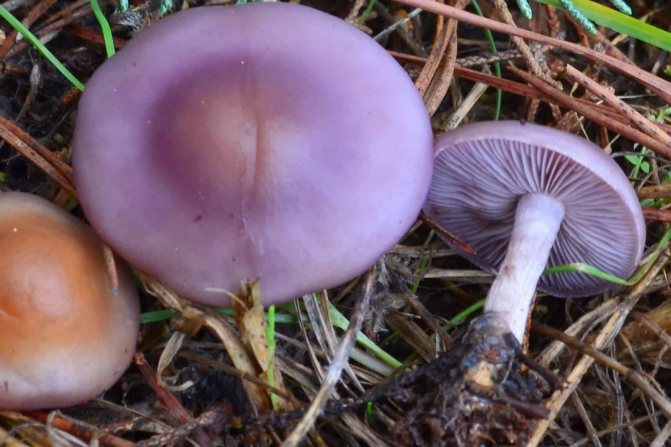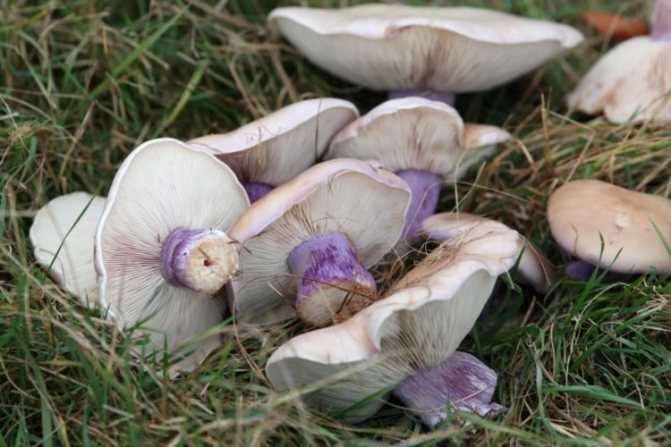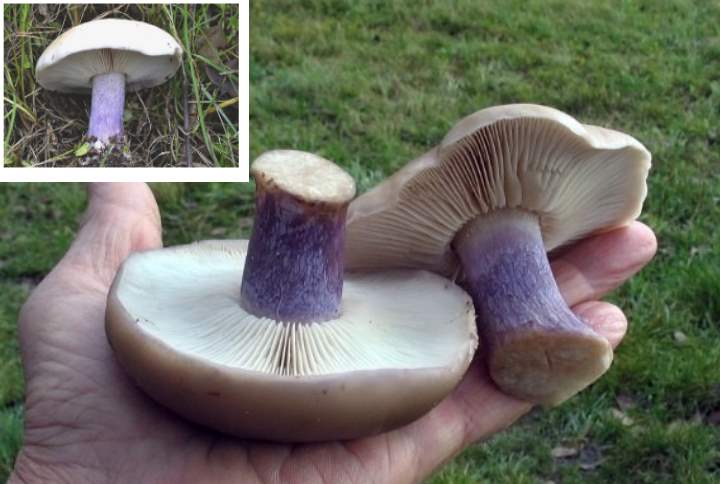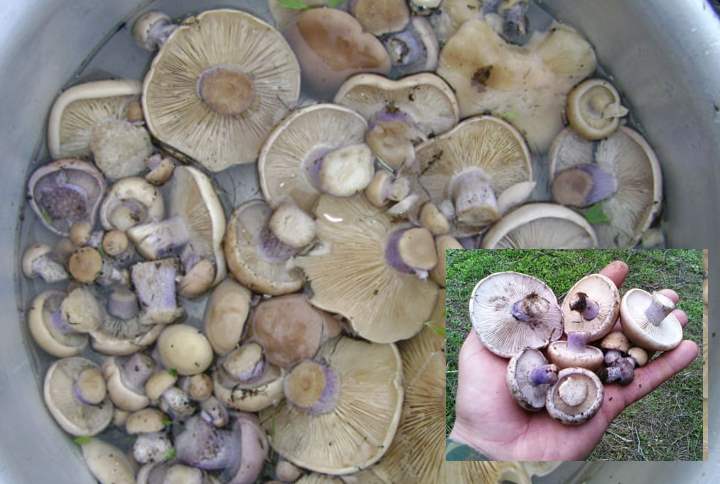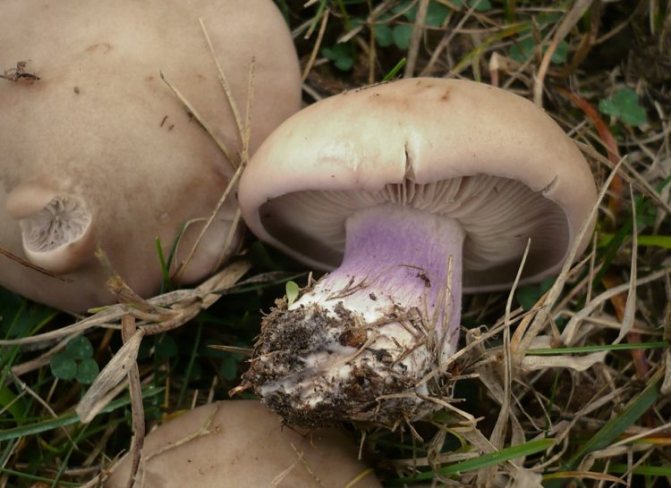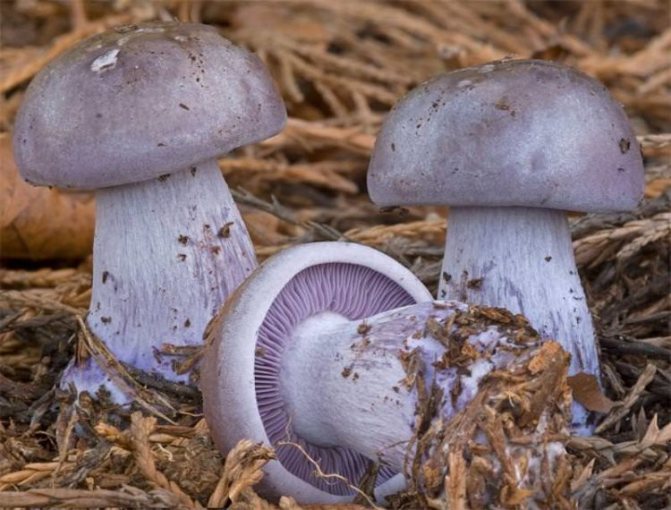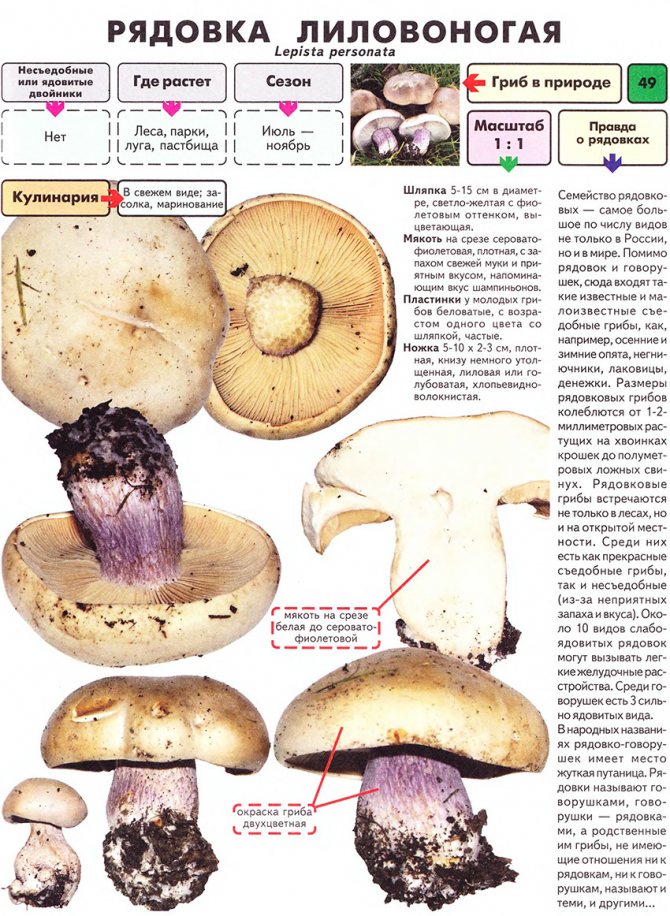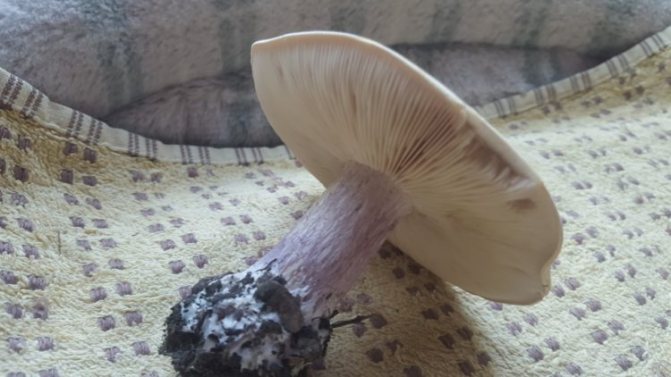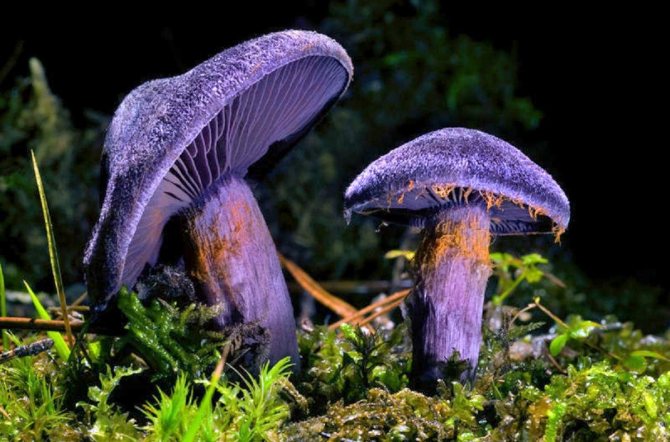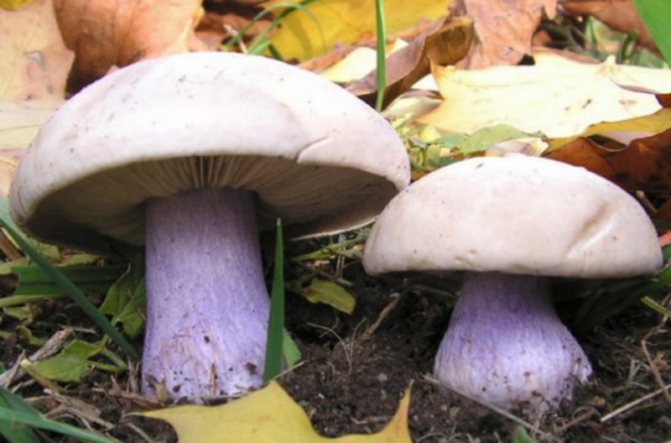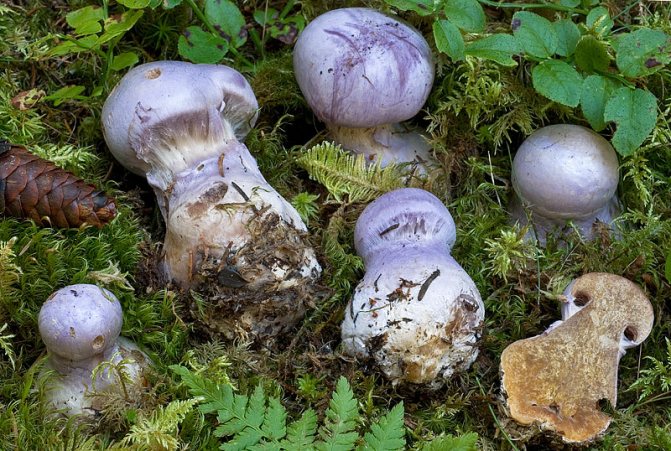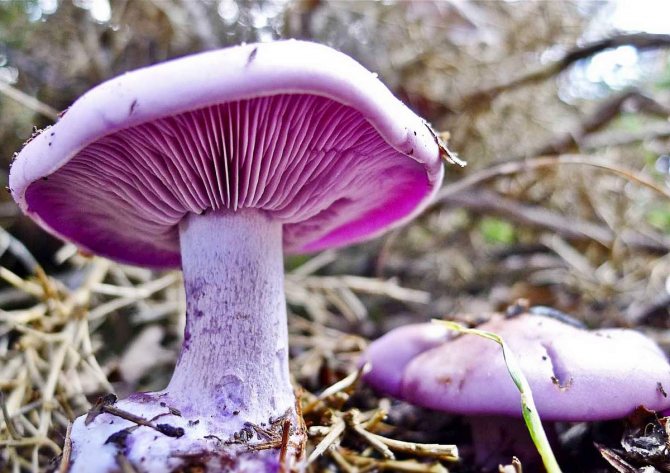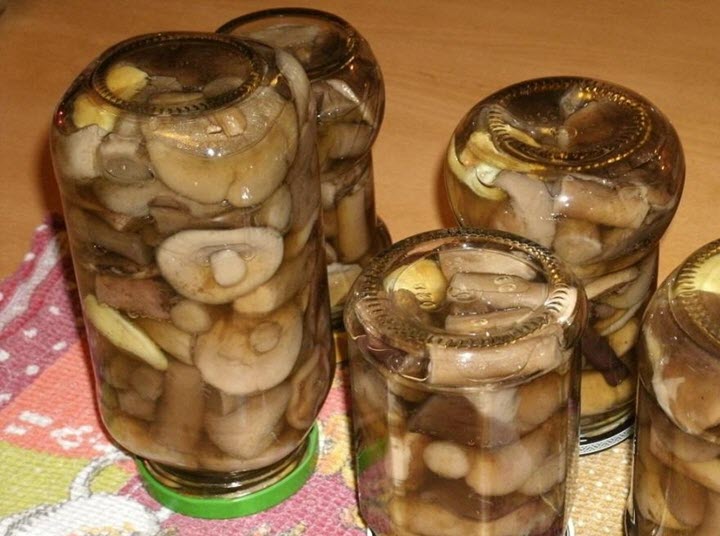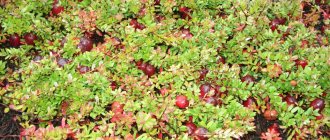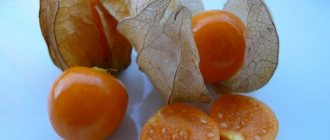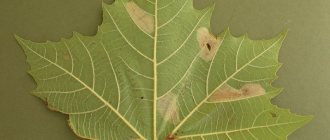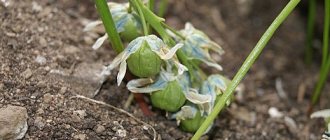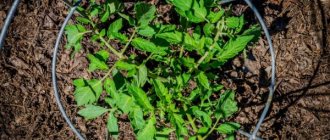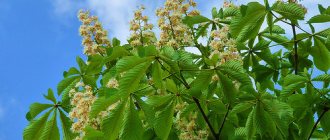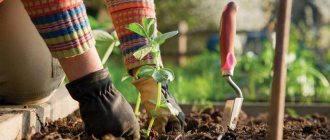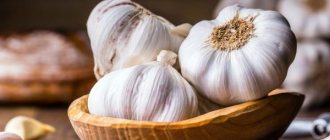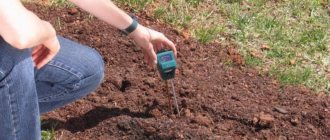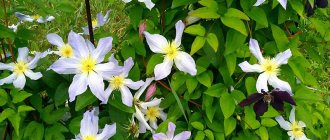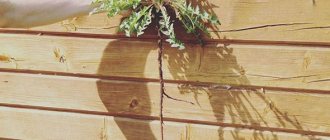Other name
- Rowing lilac-leg;
- two-color row;
- bruise;
- teacher;
- blue root;
- Lepista personata;
- Lepista saeva.
Did you know? Ryadovka is not only a delicious mushroom, but also a good beautician. The powder from its dried fruit bodies is used to make facial lotions that help get rid of acne and excess oiliness in the skin.
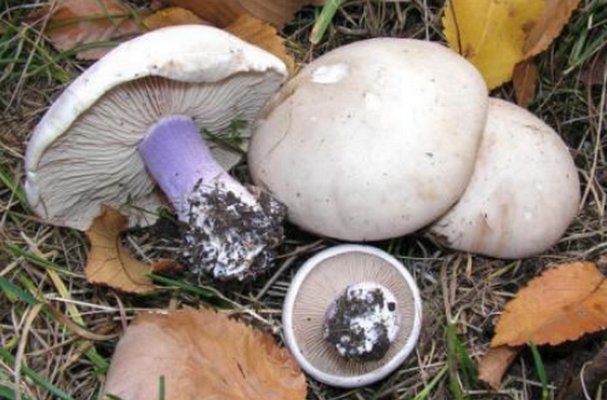
Similarity with other species
Due to its appearance and distinctive feature - a blue leg - the lilac-legged row is difficult to confuse with some other mushroom. But there are several types quite similar to it:
- the row is purple - it differs from the bruise in that it has a blue or purple color not only of the legs, but also of the cap;
- weed row - less large in size with a thinner leg;
- goat's webcap - differs in a more massive structure and a specific smell, reminiscent of the smell of a goat or acetylene.
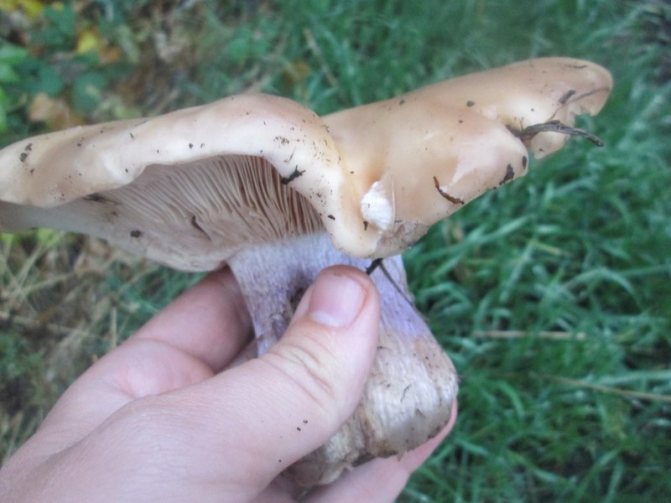

If the purple and weed ryadovki are edible mushrooms and their collection into the basket will not have negative consequences, then the goat webcap is a poisonous mushroom. But due to its special smell, it can be easily identified.
Edibility
Bluefoot is an edible mushroom suitable for human consumption with good nutritional qualities. It tastes great and is good in any form, especially pickled.
We recommend reading about how they look, is it possible to eat and how to cook purple, gray and poplar rows.
Useful properties and features of the blue leg
Bluefoot, like other representatives of ordinary ones, contains many vitamins and nutrients. It:
- amino acids;
- lipids;
- potassium;
- manganese;
- phosphorus;
- selenium;
- aspartic acid, which is a natural antibiotic;
- folic acid;
- vitamin E;
- vitamin K1;
- glycine.
Blue feet have the following useful properties:
- suppression of the activity of pathogenic microorganisms;
- strengthening of the coronary vessels;
- normalization of blood sugar levels;
- elimination of free radicals from the body;
- improving the work of the cardiovascular system;
- stabilization of blood pressure;
- preventing the development of depressive conditions;
- removal of toxins from the body;
- decrease in the severity of inflammatory processes;
- stimulation of the urinary and biliary system;
- prevention of the development of dermatological diseases.
What does it look like
The lilac-footed row, or bluefoot, is a lamellar mushroom, which got its name from the color of the leg.
Hat
The lilac-footed row has a pillow-shaped, flat-convex cap, which flattens slightly with age. The cap is fleshy, with edges bent inward, which in older specimens may turn slightly outward.
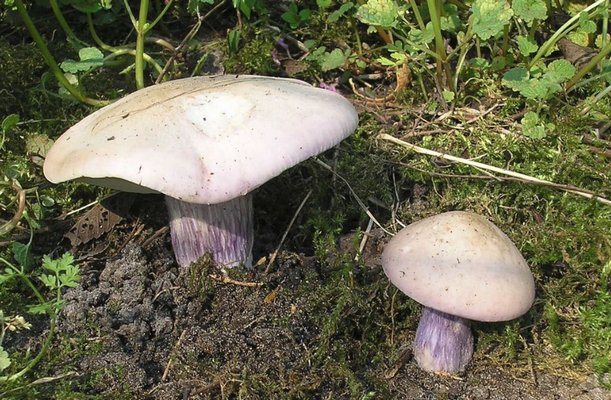

Its surface is smooth and slightly oily to the touch, the color is yellow-brownish with a slight purple tint. The diameter of the cap can be up to 15-16 cm.
It will be useful for you to read about which mushrooms are edible and poisonous, which edible mushrooms grow in autumn and May, as well as learn how to check mushrooms for edibility using folk methods.
LPs
The two-color ryadovka belongs to the lamellar mushrooms: its plates are wide, frequent, loose, or are attached notched. The color of the plates is yellowish, cream, gray or pinkish cream. Young specimens have whitish blades.
Pulp
The flesh of the bruise has a dense and thick structure, which becomes looser with age. Its color is light purple, gray-violet, gray and grayish-brown are also found. The pulp has a pleasant mealy aroma, and its sweetish taste is reminiscent of champignon.
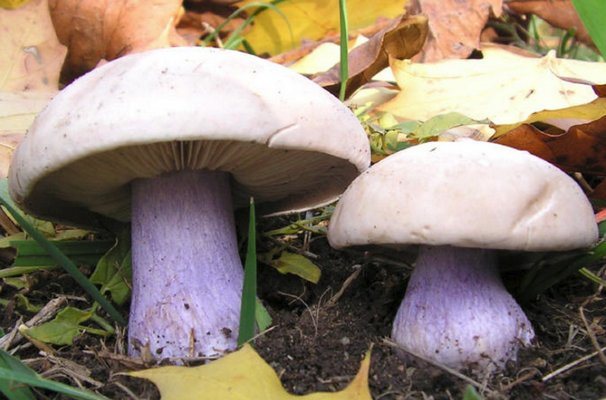

Important! If you decide to cook middle-aged specimens of blue feet, then before that you should remove the lower spore-bearing layer of the cap - the plate, since the numerous mature spores contained in them are practically not digested.
Leg
The main distinguishing feature of a two-color row is its leg. It has a distinct lilac shade, and the younger the specimen, the more expressive the color. Also, the legs are grayish-purple, and sometimes even bluish. There are mushrooms with a light stem and distinct bluish and purple fibers located on it.
The stalk of young fungi is covered with flakes with a distinct fibrous structure, which are the remains of a bedspread. With age, its surface becomes smooth. The shape of the leg is even, dense, slightly thickened at the base. Its height reaches 10 cm, and its diameter is 3 cm.
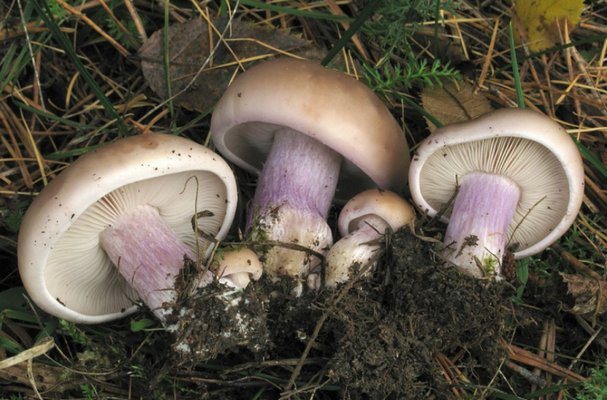

Characteristic
The description of the species includes several distinctive features that distinguish it from others:
- a small rounded fleshy cap with a diameter of 5 to 12 cm, in an adult mushroom it is flat;
- the edging is wavy, scarred, the color range is varied - gray, yellow, brown or cherry;
- under the cap there is a spore-bearing layer - a hymenophore, represented by large plates of a white or yellow hue;
- the fruit body is planted on a thick, erect leg, slightly curved at the base: in young specimens, the color is snow-white, the taste is bland, in old specimens it is a dark gray tone with a fruity aroma.
This mushroom can be found in mixed and coniferous forests, where the soil is high in calcium.
Where it grows and when can it be harvested
The lilac-footed row grows on moist, humus-rich alkaline soils and belongs to the category of southern mushrooms. Distributed in Europe and America, loves open areas - forest clearings, river banks, meadows, pastures and farms.
Sometimes found in the forest, especially near deciduous trees. The bluefoot grows in colonies, forming rather large circles or rows. This allows you to pick up a whole basket of mushrooms, practically without leaving one place.
Fans of quiet hunting will be interested in reading about what mushrooms grow in Rostov, Saratov, Volgograd, Leningrad, Kaliningrad regions, central Russia, Krasnodar Territory and Bashkiria.
Bluefoot is common throughout Russia; it can be found in the Moscow region and in the Ryazan region. The fruiting season begins in April and lasts until the end of October, but the most active time is autumn.
Video: rowing cephalopod Mushrooms are quite cold-hardy and are found even at the beginning of winter. Inveterate mushroom pickers recommend collecting blue feet in dry weather, as in wet they become slippery and rather sticky.
Important! Do not eat too many blue feet, in whatever form they are cooked. Although they are edible mushrooms, they still require good digestion and in excessive quantities can overload the gastrointestinal tract and cause upset.
Answers to common questions
Mushrooms are boiled for 15-20 minutes in water with the addition of salt. The readiness of the blue feet can be determined by how they are located in the pan. If done correctly, they will drown. After boiling the bruises, the water should be poured out, it should not be eaten.
The blue-stemmed mushroom is very unusual. With its amazing color, it sometimes frightens inexperienced mushroom pickers. It is nevertheless edible. Bluefoot is very tasty boiled, fried, pickled, it is added to a wide variety of dishes.It is important to remember that there are mushrooms in nature that are similar to this one. Since there are poisonous among the twins, you need to be vigilant when collecting.
The lilac-footed ryadovka, or bluefoot, belongs to the genus of ryadovki and, despite the specific color that frightens off some mushroom pickers, deservedly found its connoisseurs. In addition, it is one of those rare mushrooms, the growing season and collection of which can continue even during the first light frosts. This makes it possible to extend the mushroom season and get even more pleasure from a quiet hunt.
What mushrooms look like
Due to its appearance and noticeable leg, the lilac-footed ryadovka is rather difficult to confuse with other mushrooms. However, there are also similar mushrooms, such as the purple ryadovka (Lepista nuda). But if the bruise has a light cap and a painted leg, then the purple row is completely purple.
Also, during a quiet hunt, you can find a dirty, or weedy, row (Lepista sordida), which also stands out with a lilac shade of the surface, but has a much smaller size. Both of these similar mushrooms are edible, so they will not cause poisoning.
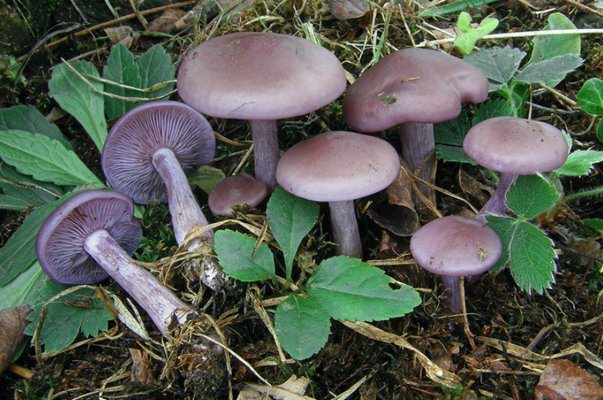

The row is dirty
Some poisonous mushrooms, for example, goat's webcap, are a bit like a two-color ryadovka. However, it has a flesh with an extremely unpleasant odor, reminiscent of acetylene or goat, so it is rather difficult to confuse them.
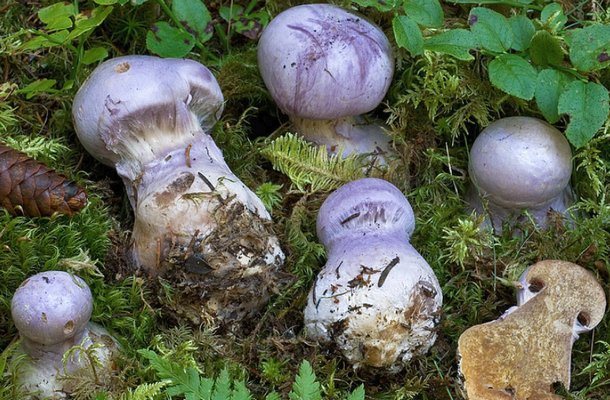

Goat webcap
Growing area
Bluefoot grows throughout the European part of Russia, as well as Kazakhstan. This fungus can be harvested until the very frost, as it withstands first frosts well.
Usually bluefoot grows under conifers or ash trees. It often grows in groups of several fungi. If the mycelium is not disturbed, then the blue leg can grow several times in the same place. Mushroom pickers who know mushroom places collect more than two hundred kilograms of blue feet per season.
It grows well in places where there is humus, so they can be found in places where manure and humus accumulate, as well as on fallen leaves and near fences. Rows grow even in meadows in grazing areas.
Features of the mushroom:
- A very rare fruity odor that is unique to this mushroom. Some experienced mushroom pickers say that this smell is similar to pineapple.
- Only young blue feet will be tasty. The old ones pick up moisture and become unpleasant to the taste and completely unhealthy.
- The leg is purple in color. It is quite dense and long.
- Young mushrooms are completely purple.
- The bluefoot can only be confused with edible mushrooms. It looks like a purple ryadovka and a May mushroom.
- Grows well in the garden in fertilized soil.
How it is used in cooking
Lilac-footed row - although not the most common, but rather tasty and aromatic mushroom.
Taste qualities
Bluefoot is recognized as an edible species suitable for human food. It has a very pleasant soft taste, reminiscent of young mushrooms. Such excellent taste allows it to be widely used for culinary purposes.
What is it suitable for
Lilac-footed ryadovka is consumed fried, boiled, salted and pickled. It is sometimes dried, but this is not very common. Pickled and salted blue feet are especially valuable in taste. But they should not be consumed raw.
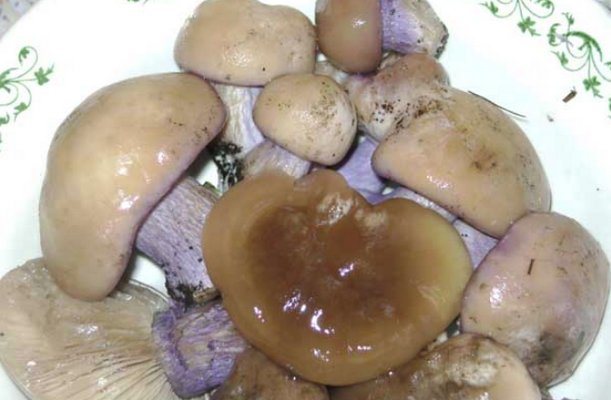

Due to its high protein content and overall low calorie content, mushrooms are a good addition to the diet of those on a diet. They allow you to diversify the table and do not add extra calories to it.
Learn more about how edible mushrooms look like dung beetles, chanterelles, talkers, common oak trees, boletus boletus, aspen mushrooms, volushki, veselki, violins, raincoats, sandpipes, mokrukh, meadow mushrooms, boletus mushrooms, pigs, champignons, milk mushrooms, oyster mushrooms, boletus.
How much to cook
Before use, the lilac-legged rower must be boiled in salted water for 15–20 minutes. This should be done immediately after picking, as raw mushroom storage is rather poor. Willingness can be determined by the fact that the bruises sink to the bottom. The broth cannot be used, it must be poured out.
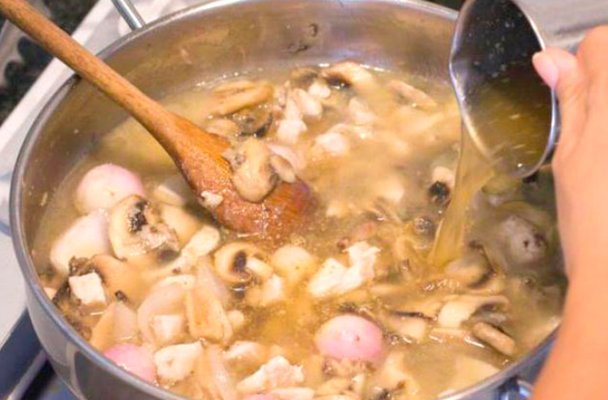

How to pickle
Ingredients:
- bluefoot - 1 kilogram;
- water - 1 liter;
- salt - 2 tbsp. spoons;
- sugar - 2 tbsp. spoons;
- vinegar essence (9%) - 1 tsp;
- bay leaf - 2-3 pieces;
- black currant leaf - 5-6 pieces;
- black pepper - 8 - 12 peas;
- medium clove of garlic - 5-6 pieces.
Check out the recipes for making pickled rows.
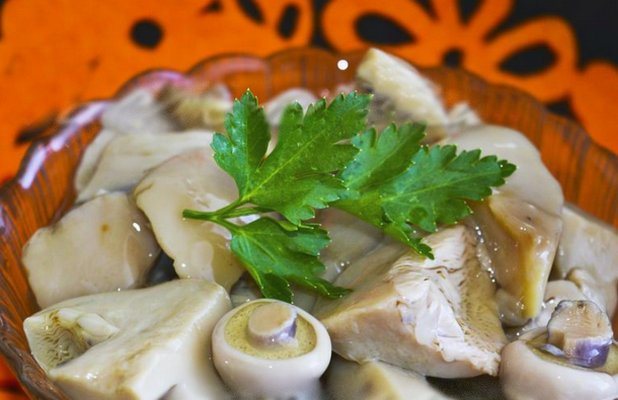

Step by step recipe:
- Sort the rows, rinse well, clean and select only the caps.
- Boil the caps in a large amount of slightly salted water for 20-30 minutes, let the water drain, throwing the mushrooms in a colander.
- Prepare a marinade from water, salt and sugar, adding bay leaves, black currant leaves and black pepper, boil for 10 minutes over low heat.
- Add garlic and vinegar a couple of minutes before finishing.
- Arrange the finished hats in sterilized containers, fill with strained marinade and roll up with turnkey lids.
- After cooling down, send the jars for storage in the closet or refrigerator.
Video: pickling mushrooms
Did you know? Among the Japanese, the mushroom of the Ryadovkovy matsutake family (from the Japanese "pine mushroom") is valued no less than the famous truffle among the Europeans. Fried matsutake is a rather expensive delicacy; individual copies can cost up to $ 100.
Lilac-footed rows are excellent mushrooms with a pleasant taste and aroma, from which you can prepare a wide variety of dishes. Having tried them at least once, you will no longer pass by the blue feet, and it will definitely end up in your basket. Happy hunting and bon appetit!
Varieties
To learn how to distinguish edible Sinyavki from counterparts - false mushrooms, you need to familiarize yourself with their detailed description.
Edible
The podgruzdok is white (the russula is excellent or pleasant). The young fruit body is characterized by a snow-white cap, sometimes covered with light yellow spots, has a convex, funnel-shaped shape.
The leg is of small height, narrowed to the bottom, snow-white or brown. Mushroom places are mixed and coniferous forests. The collection is carried out in summer and autumn.
The russula is yellow. Young specimens have a spherical, yellowish hat, later it takes on a flat shape. Diameter depending on age - 5-10 cm. The skin along the edge can be easily peeled off. The leg is white. The plates are first snow-white, then light yellow, in the old ones they are grayish. The pulp is white, turns gray when broken, then turns black.
The edible sweetish mushroom is found in the summer and autumn period. Growing places - birch and pine forests.
Blue russula (azure). It grows mainly in coniferous forests, mainly in spruce forests, where it forms whole nests. You can identify it by a white leg 3-5 cm high and a bluish cap with a circumference of 3-10 cm. Young mushrooms have a solid leg inside. but in older ones it is already hollow or even a lot of chamber.
Greenish. In appearance, it does not differ in particular attractiveness, but of all the varieties of russula, this mushroom is the most delicious. It got its name from the color of the cap - green or gray-green, with a diameter of 10 cm. The peel can be easily removed to almost half of the cap. Places - coniferous and deciduous forests.
The leg is white with dense flesh.
You should be careful when collecting, as this mushroom is very similar to the pale toadstool.
Inedible
Birch russula. It prefers to grow in the root part of birches, appears in early summer and bears fruit until the end of autumn. The skin is easily removed from the surface of the cap.The color is very diverse, but most often it is lilac-pink with a central yellowish spot. The leg is wrinkled, often hollow, it gets wet during rainy weather.
Russula blood-red. It is found mainly in pine forests. The cap has a flat-convex shape, saturated scarlet color, a circumference of 6-7 cm. The peak of fruiting occurs in July-September. Not used for food because of its bitter taste. Eaten raw can cause food poisoning and gastrointestinal problems.
The russula is pink. The hat is pink in color (it can often range from red to dark pink), funnel-shaped, and later acquires a flat-round shape. These mushrooms are bitter.
They grow in deciduous and coniferous forests, the peak of fruiting occurs in early July and late September.

